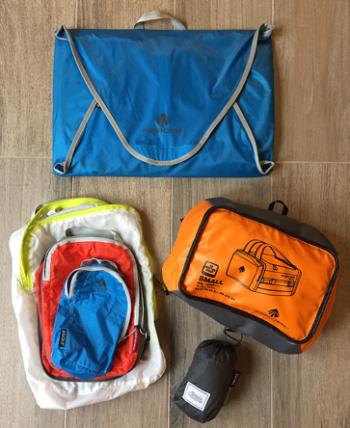Traveling ultralight
This item appears on page 43 of the February 2019 issue.
I've got a theory about how we pack for travel. What we pack and how much we pack are often a result of one's travel experience and age.
As a twenty-something on my first trip to Europe in 1981, I packed everything I thought I needed for five weeks in Greece and Turkey into a carry-on-size soft piece of luggage with grab handles and a shoulder strap but no wheels.
I had several shirts, a pair of shorts, underwear, socks, a hat, a wind shell and a razor with shaving cream. That was it. No extra shoes, rain gear, dressy outfits, etc.
Fast-forward 20 years, and my 2-week trips to Europe and Asia included more contingency clothing and gear — a lot more stuff that I managed to cram into a wheeled carry-on bag and medium-size backpack.
But my pride in packing so much in so little space wore thin as the travel days added up and the suitcase felt heavier as I moved from place to place, lugging it into and out of trains, cabs and hotel lobbies.
Now, at age 60, I've entered a new phase: traveling with less. It's back to the future but with more attention to comfort in varying conditions.
Living 15 days out of a duffel
When I cycled solo across the country six years ago, I was careful to pack only what I thought was essential for survival on a bicycle, paring my possessions down to 18 pounds of gear, including a small tent, sleeping bag, sleeping pad and camp stove.
Six weeks and 1,600 miles into the trip, I realized I seldom needed the camping equipment because I managed to stay at a cheap motel or cabin every night (called "credit card cycling"). So I pared things down even more and mailed 7 pounds of equipment back home.
Extreme example? Yes. But I needed very little in the way of wardrobe besides my cycling kit. Here's a less extreme situation.
Packing for Africa
In 2017 I was part of a humanitarian mission installing water wells in rural northwestern Tanzania. We were to fly via Emirates from Los Angeles to Dubai (16 hours), overnight in Dubai and then depart early the next day for the 5-hour flight to Entebbe, Uganda. The following day, we'd drive eight hours to Tanzania.
I was determined to pack most of my gear in one carry-on bag plus a personal item (backpack) and remain within Emirates' 15-pound (7-kilogram) weight limit for carry-on luggage. That weight restriction pretty much precluded using a wheeled luggage piece.
I started with a lightweight duffel weighing 2 pounds empty. This bag had shoulder straps (so it could be carried long distances) but no wheels or frame to weigh it down. It had one main compartment easily accessed by a large, U-shaped, zippered opening and two smaller end compartments, each with its own zippered access, for a little more organization.
The bag I chose was Eagle Creek's small Cargo Hauler duffel (45-liter capacity). I used a garment folder to pack shirts and pants, a medium-size packing cube to pack underwear and socks, and a tiny cube for toiletries. It was a simple way to organize stuff and make unpacking and packing easier. (These organizers are virtually weightless empty.)
Additionally, I took a 16-liter-capacity waterproof backpack from Matador for the little things I'd need easy access to on the long flight and long jeep rides in the bush. This weighed 4 ounces empty.
What I packed
Here's what I considered the minimal wardrobe for lightweight packing for this East African destination (based on my choices as a guy going to a semiarid equatorial region at an elevation of roughly 4,000 feet — low humidity, benign temperatures and intense sunlight):
• 4 lightweight nylon, button-up shirts with pockets and sun-blocking features (I included one that had built-in insect repellent) and a T-shirt. Nylon fabric is really lightweight, does not stain easily, can be washed and dried by hand and packs very flat.
• 1 pair of lightweight nylon, khaki-colored pants for field work.
• 1 pair of nylon shorts, preferably with pockets, for workouts, swimming and hot days of touring.
• 5 pairs of socks — wool/nylon blend for low absorption and low odor and for comfort.
• 5 pairs of nylon travel undies. ExOfficio sport briefs pack down to nothing and are very comfortable in all temperatures. These also can be washed in the sink, toweled off and then hung to finish drying overnight. (I packed different colors to help me remember what was dirty and what was clean.)
• 1 pair of flip-flops for the hostel and shower.
• 1 pair of running shoes.
• 1 nylon hat with an all-around brim for sun protection.
• 1 lightweight rain shell that packed in its own hood.
In my toiletry kit, I carried just the essentials for comfort, personal hygiene and pain relief: razor and shaving oil; travel-size shampoo; folding brush; travel-size hair gel; toothbrush and floss; Band-Aids and antibacterial ointment; ibuprofen; sunscreen; bug repellent, and earplugs.
I also took a braided latex laundry line and small detergent packets for hand-washing garments.
What I wore en route
For the long flight, I dressed with comfort and practicality in mind….
Shirt with pockets for travel stuff.
Casual pants in a blend of cotton/polyester fabric, for comfort and ease of care (less likely to wrinkle and more stain resistant than pure cotton) and suitable for an evening at a restaurant.
Hiking shoes (I packed my lightweight running shoes, which took up less space).
Other essentials
In my backpack (what the airlines call your "personal item"), I carried a lightweight wool sweater and a bunch of little things, including a journal, pen, paper map, iPad mini (for books and movies), earbuds (more compact than headphones), reading glasses, sunglasses, passport, adapter plug, snacks, a small power bank for recharging my phone, and a little of the local currency.
For this trip to Tanzania, my packed cargo duffel weighed under 11 pounds and the loaded backpack around 2 pounds.
What not to take
Of course, the following suggestions for what not to take are purely personal preferences, but think about what you really need, not what might be nice to have.
Printed books. Take a tablet or read from your phone, as books are heavy and bulky. Take photos of key guidebook pages or rip out and take just the important pages.
Shoes are among the biggest space and weight hogs, so wear comfortable shoes on the flight and pack only one additional pair of shoes. You should be able to get by with two pairs plus a pair of sandals or flip-flops.
Sleepwear. Pajamas are an unnecessary luxury, as undies and a T-shirt work just fine.
Hair care and personal care products are really heavy and bulky, and any container holding more than 3 ounces will force you to check your bag.
Hair dryer. Nicer hotels usually have them. Hair curlers and straighteners are luxuries.
Digital camera. Your phone works well in many instances, but photography buffs may want to take a better camera along.
Alarm clock, flashlight, currency converter and translator all are obsolete, as your smartphone handles all of these functions.
Metal water bottle. Just buy a plastic bottle of water and refill it during your travels. Aluminum dual-wall bottles are great at keeping cold things cold and hot things hot, but they add weight and bulk.
Denim and heavy twill fabrics are impractical, as they are heavy and take forever to dry on their own.
Leather handbags or shoulder bags are way too heavy and impractical.
•
It turned out that Emirates never weighed our carry-on bags in either direction, so the paring down was purely for personal benefit.
Would I do it again? Yes! In fact, I'm packing right now for two weeks in New Zealand in the same two small bags. Less is more!
Mark Gallo owns CircaTerra Travel Outfitters (Santa Barbara, CA; 805/568-5402, circaterra travel.com) and can be reached at [email protected].



